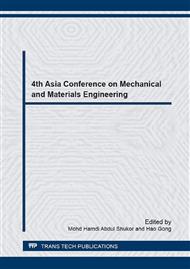p.59
p.63
p.69
p.73
p.77
p.83
p.90
p.95
p.99
A Study on Free Vibrational Response of Functionally Graded Nanocomposite Sandwich Plates Reinforced by Randomly Oriented Straight Carbon Nanotubes
Abstract:
This paper is motivated by the lack of studies in the technical literature concerning to the three dimensional vibration analysis of thick laminated rectangular plates with continuously graded carbon nanotube-reinforced (CGCNTR) sheets. The formulations are based on the three-dimensional elasticity theory. The proposed rectangular plates have two opposite edges simply supported, while all possible combinations of free, simply supported and clamped boundary conditions are applied to the other two edges. The structure is supported by an elastic foundation with Winkler’s (normal) and Pasternak’s (shear) coefficients. The material properties of the functionally graded carbon nanotube reinforced composites are graded along the thickness and estimated through Mori-Tanaka method.
Info:
Periodical:
Pages:
77-82
Citation:
Online since:
November 2016
Authors:
Price:
Сopyright:
© 2017 Trans Tech Publications Ltd. All Rights Reserved
Share:
Citation:


